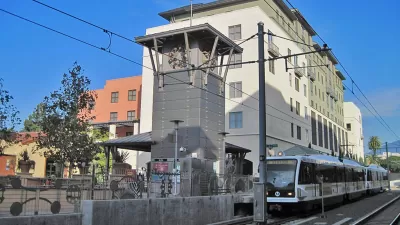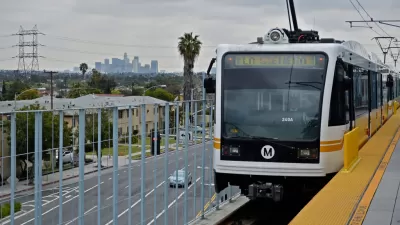A Los Angeles Times columnist hears about the Los Angeles density controversy and sees its implications during a recent drive around town with County Commissioner Zev Yaroslavsky.
"'The planners in this city are bamboozling people, including some of the members of City Council,' he said, tossing one cluster bomb after another on an otherwise quiet Sunday morning."
"He drew diagrams on my note pad, explained how protections against overdevelopment are being plundered, charged that claims of new affordable housing are bogus and predicted that quiet neighborhoods of single-family homes will be thrown into permanent shadows by towering behemoths."
"It's an apocalyptic view, but is he right that city officials have handed over control to developers?"
"With all their talk of 'infill' and creating a denser core, city officials have done little to allay the fears of those who believe, as Yaroslavsky does, that developers are enjoying one heck of an orgy these days and that it's now easier than ever to get approval for larger buildings and fewer parking spaces."
"Hundreds of residents showed up three weeks ago at a meeting to register complaints about seven proposed mega-projects in the North Hollywood/Universal City area. And even city Planning Commission President Jane Ellison Usher has warned that the density-promoting housing rules approved by the city in February are 'ripe for litigation.'"
"Yaroslavsky said planners are using a 'one size fits all' philosophy that ignores the uniqueness of each neighborhood."
FULL STORY: Touring L.A.'s growth in a fury

Alabama: Trump Terminates Settlements for Black Communities Harmed By Raw Sewage
Trump deemed the landmark civil rights agreement “illegal DEI and environmental justice policy.”

Planetizen Federal Action Tracker
A weekly monitor of how Trump’s orders and actions are impacting planners and planning in America.

The 120 Year Old Tiny Home Villages That Sheltered San Francisco’s Earthquake Refugees
More than a century ago, San Francisco mobilized to house thousands of residents displaced by the 1906 earthquake. Could their strategy offer a model for the present?

Indy Neighborhood Group Builds Temporary Multi-Use Path
Community members, aided in part by funding from the city, repurposed a vehicle lane to create a protected bike and pedestrian path for the summer season.

Congestion Pricing Drops Holland Tunnel Delays by 65 Percent
New York City’s contentious tolling program has yielded improved traffic and roughly $100 million in revenue for the MTA.

In Both Crashes and Crime, Public Transportation is Far Safer than Driving
Contrary to popular assumptions, public transportation has far lower crash and crime rates than automobile travel. For safer communities, improve and encourage transit travel.
Urban Design for Planners 1: Software Tools
This six-course series explores essential urban design concepts using open source software and equips planners with the tools they need to participate fully in the urban design process.
Planning for Universal Design
Learn the tools for implementing Universal Design in planning regulations.
Clanton & Associates, Inc.
Jessamine County Fiscal Court
Institute for Housing and Urban Development Studies (IHS)
City of Grandview
Harvard GSD Executive Education
Toledo-Lucas County Plan Commissions
Salt Lake City
NYU Wagner Graduate School of Public Service





























